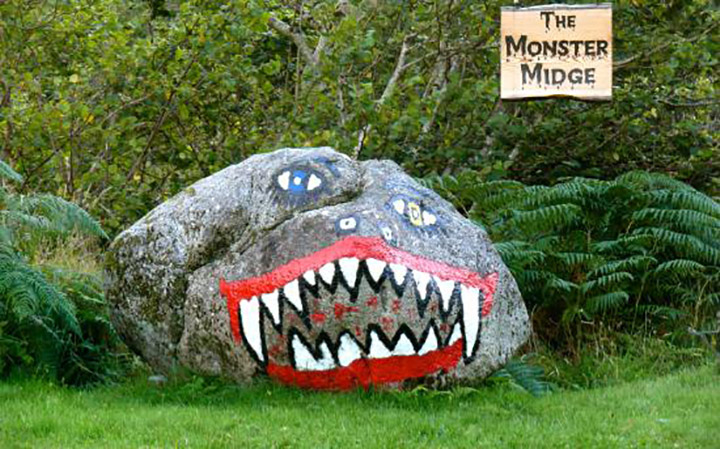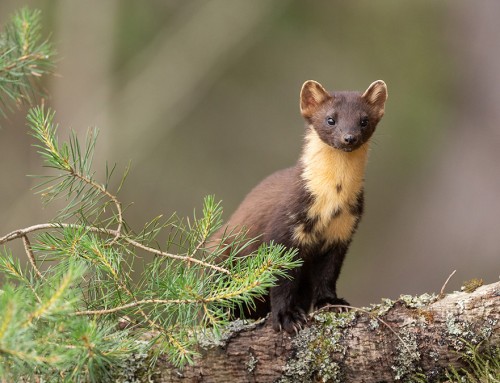In any combat scenario it is essential to know your enemy, so here then is the lowdown on that most fearsome of opponents, that fabled beast known for defeating intrepid globetrotters and reducing the most hardened holidaymakers to tears. The Scottish midge.
Complaining about the midges or “a’chuileag” in Gaelic is a national obsession, a bit like grumbling about the weather but forearmed with the appropriate supplies and background information your holiday to the highlands need not end in retreat or surrender.
Midges are tiny flying insects and are most commonly found in the north and west of the highlands between the months of June and September. The males are passive and of limited bother. Although not dangerous, it is the adult females of the species that are the extreme nuisance for visitors. They carry more eggs than they can mature – to provide the yolk for the additional eggs they require protein from blood. Locals, tourists or cows, they are really not too fussy where it comes from. To avoid becoming an all you can eat buffet for these vampiric pests there are a few simple steps you can take.
Fashion is a difficult thing to get right in the moorlands and glens of the Highlands, coordinating your wardrobe with the colours of the season is never easy, but for hipsters the colour to be seen in this season is definitely white. Midges are attracted to dark colours so the lighter the better and if fashion faux pas don’t worry you, then baggy garments, multiple layers, trousers tucked into your socks and tops tucked into your belt will help prevent the little blighters from penetrating your defences. The tiniest amount of exposed flesh is often enough to allow the most persistent in and call for reinforcements. A midge net worn under a zipped up hoodie may look like some sinister superhero costume but short of a spacesuit it’s the best option for survival when the conditions are unfavourable.
Sunny days, breezes and getting out on the water are great way to avoid the midge!
Conditions for midges can actually be predicted fairly accurately. If you are flexible then it is possible to minimise your exposure or even avoid them altogether. The Scottish Midge Forecast does a great job, collecting data from traps and weather stations across the country to give an accurate prediction of where they are most likely to be hiding. In general they like specific conditions and times of day. Bright sunlight puts them off, as does even the most gentle breeze. They like warm and damp conditions the best, which makes dawn and dusk particularly attractive to them. They are usually found in damp and uncultivated places where there is a lot of undergrowth or thick vegetation, and areas where livestock are kept as they will happily munch on a cow if there are no tourists about. On days when conditions are particularly overcast, or it has just recently been raining, it is wise to have a back-up plan that avoids forests or fields. Fortunately there is no shortage of midge free things to do. A personal favourite is to go out for a paddle as midges don’t travel over water too well and usually you don’t have to go very far out to sea to be clear of them completely. In the evening a smokey camp fire can keep them at bay. Altitude also means less midges with them being significantly less common over 700metres, coupled with the increased likelihood of a bit of a breeze then the attraction of Munro bagging increases exponentially.
As long as there have been midges there has been fierce debate about how best to repel them. Natural remedies, old wives tales or chemical spray, everyone seems to have their own favourite. Traditionally crofters would tie bog myrtle around their ankles. More recently, in the middle of last century, smoking cigarettes was a common method of survival. For those who think chain smoking for an entire holiday to be a tad unhealthy then there are those that believe that an ale before venturing outside does wonders as these evil fiends don’t like the yeast in the blood. Teetotallers can apparently consume a spoonful of marmite for the same effect.
There are also those who believe that midges are attracted to a certain odour, so a clove of garlic eaten every day for a week before your holiday will repel the little monsters as long as you also remember not to use shampoo, scent or aftershave. The fashion conscious can somehow redeem themselves with a superband insect repelling wristband. It may not be the most effective but it does come in a range of pretty colours.
Midges are attracted to the increased amounts of carbon dioxide in the atmosphere caused by breathing so without holding your breath they are going to find you sooner or later.

The most sensible option (and probably the healthiest) would be to use one of the specifically designed anti midge creams or sprays on the market. DEET was for many years the most popular product available, its chemical formula is incredibly potent but due to its strength caused problems for many users. Such was its potency it could melt certain plastics and if sweat mixed with it ran into your eyes during exercise then it could cause uncomfortable stinging. Smidge has all the benefits of DEET but without the side effects and has been an essential feature at the bottom of most hillwalkers backpacks for many years. Skin So Soft by Avon is another more natural product that was originally designed as purely a beauty cream, but has proved so successful at repelling midges that it is now used by the British army, an institution not generally renowned for their skin care regime. If you prefer something completely natural, Bug Soother is the one for you, although it’s effectiveness has mixed reports.
It was reported in the press a number of years ago that a wealthy golf enthusiast scrapped plans to buy Loch Lomond Golf Club when it was for sale after being “bitten to death” when playing a round there. It’s an apocryphal story, probably best taken with a pinch of proverbial salt, but it does demonstrate the perception that many outsiders have of the Scottish countryside, of an oppressive and hostile environment best avoided. The midge is a fact of life for those of us who do live here, complaining is about as much use as trying to stop the tide. Instead of retreating from the fight, confront your enemy. You may find it’s not as scary as you thought.






